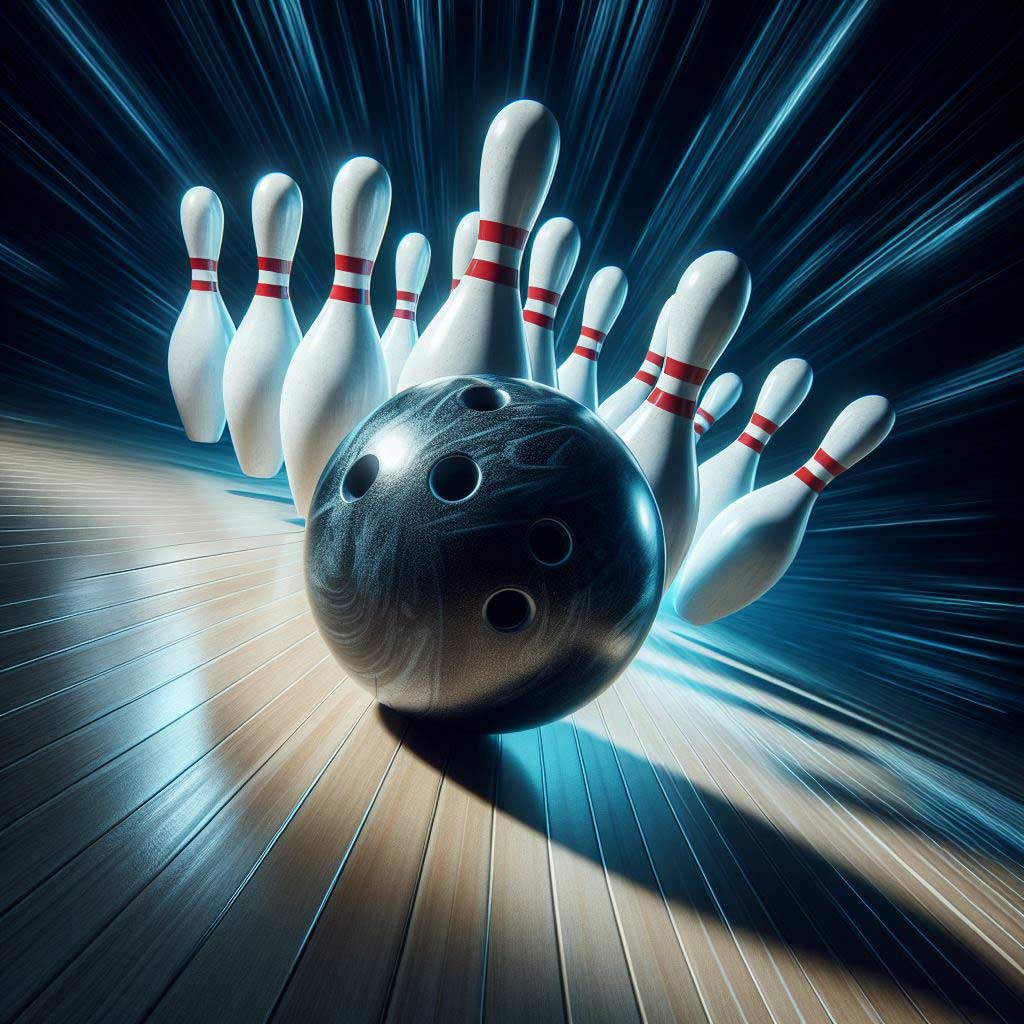As any experienced 9 pin bowler knows, being able to consistently roll a “ringer” – where you knock down all 9 pins with a single shot – is the holy grail of this unique bowling format. Not only does the ringer shot result in a hugely satisfying strike, it’s also the key to racking up high scores and winning matches.
In traditional 10 pin bowling, a strike where you knock down all 10 pins is certainly impressive, but it’s a relatively common occurrence, especially for skilled players.
In 9 pin, however, the ringer shot is far more elusive. The smaller pin configuration, angled pin deck, and unique pin set-up make it a much more technically demanding shot to execute.
That’s why mastering the ringer is so important for any 9 pin bowler who wants to take their game to the next level. With the right technique and consistent practice, you can develop the ability to knock down all 9 pins with a single, powerful roll – giving you a major advantage over your opponents.
In this comprehensive guide, we’re going to break down everything you need to know about the ringer shot in 9 pin bowling. From the fundamental mechanics to advanced techniques and troubleshooting tips, you’ll learn how to develop a rock-solid ringer that will have you dominating the lanes in no time. Let’s get started!
The Ringer Shot Breakdown
At its core, the ringer shot in 9 pin bowling is all about precision and power. You need to be able to deliver the ball with the perfect combination of speed, rotation, and placement in order to cleanly knock down all 9 pins.
Let’s take a closer look at the key elements that go into executing an effective ringer:
Stance and Foot Positioning
Your starting stance and foot positioning are crucial for setting up a successful ringer shot. You’ll want to stand with your dominant foot slightly ahead of your other foot, with your weight evenly distributed. Your feet should be about shoulder-width apart, providing a stable, balanced base from which to initiate your swing.
As you prepare to deliver the ball, shift your weight primarily onto your front foot, with your back foot acting more as a pivot point. This weight distribution will help you generate power through your hips and torso as you swing the ball forward.
Your upper body should be upright and relaxed, with your shoulders square to the target. Avoid hunching over or twisting your torso, as this can throw off your alignment and ball trajectory.
Grip and Arm Swing
The way you grip the ball and swing your arm during the delivery is another critical component of the ringer shot. You’ll want to use a firm, solid grip that allows you to control the ball’s rotation and direction.
Place your thumb all the way into the ball’s thumb hole, with your fingers spread comfortably across the grip. Maintain this grip throughout your swing, avoiding any looseness or slippage.
As you initiate your backswing, keep your arm straight and elbow tucked close to your body. Your swing should be smooth and fluid, with your arm moving in a straight, pendulum-like motion. Avoid any jerky or erratic movements, which can negatively impact your ball speed and accuracy.
At the top of your backswing, your arm should be fully extended, with the ball positioned directly behind you. This will give you the leverage and power you need to deliver the ball with authority.
Release and Follow-Through
The release and follow-through are the final, critical steps in executing a successful ringer shot. As you reach the release point, focus on keeping your wrist firm and your fingers “rolling” off the ball in a straight line toward your target.
A clean, consistent release is essential for controlling the ball’s rotation and direction. Avoid any last-second adjustments or jerky movements, which can cause the ball to hook or veer off course.
After you release the ball, be sure to follow through with your swing, allowing your arm to continue in a smooth, straight motion across your body. This follow-through not only helps you maintain balance and control, but it also reinforces the proper mechanics of the shot.
Keeping your eyes focused on your target throughout the entire delivery is also crucial. This visual focus will help you align your body, swing, and release with precision.
Essential Ringer Technique Tips
Now that we’ve covered the fundamental mechanics of the ringer shot, let’s dive into some essential technique tips that will help you master this crucial skill:
Generating Enough Ball Speed
One of the keys to a successful ringer shot is generating sufficient ball speed. The 9 pin configuration and angled pin deck require a powerful, penetrating ball delivery in order to knock down all the pins.
Aim for a ball speed in the 15-18 mph range. Any slower, and you risk leaving pins standing. Too fast, and you may overpower the shot, causing the ball to miss the ideal hitting zone.
To develop the necessary ball speed, focus on generating power from your legs and core, rather than just your arm swing. Utilize your lower body to initiate the forward swing, transferring that kinetic energy up through your torso and into the ball.
A strong, fluid approach step and well-timed release will also help you maximize ball speed. Avoid rushing your delivery or relying solely on arm strength, as this can lead to inconsistent speed and accuracy.
Controlling Hook and Curve
In addition to pure ball speed, being able to control the amount of hook or curve on your delivery is crucial for knocking down all 9 pins. Too much hook can cause the ball to miss the ideal hitting zone, while too little hook may result in the ball sliding through the pins without enough impact.
The key is finding the right balance of ball rotation and entry angle to hit the 1 pin dead-center. This sweet spot will give you the best chance of clearing all the pins.
To fine-tune your ball hook, experiment with your hand position, wrist angle, and release point. A slightly closed wrist position and later, more decisive release will tend to generate more hook. Conversely, an open wrist and earlier release will produce a straighter, less curved ball path.
Pay close attention to how changes in your technique affect the ball’s trajectory, and make adjustments accordingly. Consistent practice is the best way to develop a reliable feel for controlling hook and curve.
Reading the Lane Conditions
The unique pin and lane configuration of 9 pin bowling means that lane conditions can have a major impact on your ringer shot. Factors like oil pattern, lane surface, and temperature can all influence how the ball reacts as it travels down the lane.
Becoming adept at reading these lane conditions is essential for dialing in your ringer delivery. Pay close attention to how the ball is reacting on your practice shots, and make any necessary adjustments to your speed, angle, or ball rotation.
For example, on a drier, less oily lane, you may need to play a straighter, slower shot to avoid over-hooking. On a heavily oiled lane, you might need to generate more hook to get the ball to bite and drive through the pins.
The more you can anticipate how the lane conditions will affect your ball motion, the better you’ll be able to execute consistent, high-percentage ringer shots.
Adjusting for Different Pin Configurations
Another important factor to consider is the specific pin set-up and deck angle on the 9 pin bowling lanes you’re competing on. While the basic 9 pin configuration is standard, there can be slight variations in pin placement and the angle of the pin deck.
Pay close attention to how the pins are configured on a given lane, and make any necessary adjustments to your ringer shot delivery. This may involve altering your target, changing your ball speed or rotation, or shifting your stance and approach.
For example, on a lane with a more extreme pin deck angle, you may need to aim slightly further outside to account for the increased hook the ball will generate off the steep angle. Conversely, on a flatter pin deck, you may need to play a straighter, firmer shot to get the ball to drive through the center of the pocket.
The more you can adapt your ringer technique to the specific lane conditions and pin set-up, the more consistent and effective your shots will be.
Ringer Drills and Practice Routines
Of course, simply understanding the mechanics and technique of the ringer shot is only half the battle. Developing the muscle memory and consistency to execute it under pressure requires dedicated, focused practice.
Here are some essential ringer drills and practice routines to help you take your game to the next level:
Ringer Progression Drill
Start by setting up a target – either a single pin or the full 9 pin configuration – at a short distance down the lane, perhaps 10-15 feet. Focus on delivering the ball with proper technique and precision to knock down the target.
As you gain consistency, gradually increase the distance to the target, working your way up to the full 15-foot 9 pin set-up. This progressive drill will help you build the necessary control and confidence to execute the ringer shot from the standard distance.
Pin Specific Ringer Drill
In addition to the full ringer, it’s important to practice knocking down specific individual pins as well. Set up the full 9 pin configuration, then focus on delivering the ball in a way that specifically targets the 1 pin, 4 pin, 7 pin, or any other individual pin.
This targeted drilling will help you develop the ball placement and control needed to consistently hit the ideal impact zone for a ringer. Pay close attention to how your ball reaction changes when aiming for different pins, and make the necessary adjustments.
Ringer Rhythm and Timing Drill
The rhythm and timing of your approach and release is critical for a successful ringer shot. Set up a metronome or other timing device, then practice delivering the ball in time with the beat.
Focus on maintaining a smooth, consistent tempo throughout your entire delivery. This will help you ingrain the proper timing and mechanics, making the ringer shot feel more natural and repeatable.
You can also try varying the tempo of the metronome, forcing you to adapt your timing and rhythm on the fly. This will build the adaptability and responsiveness you’ll need to execute ringers in competition.
Ringer Consistency Challenge
Once you’ve honed the individual elements of the ringer shot, put it all together with a consistency challenge. Set up the full 9 pin configuration and see how many consecutive ringers you can roll.
Keep track of your personal bests, and challenge yourself to incrementally improve your ringer consistency over time. You can even turn this into a friendly competition with fellow 9 pin bowlers.
Maintaining focus and composure under the pressure of this challenge will help you develop the mental toughness needed to perform when it counts.
Troubleshooting Common Ringer Issues
Of course, even the most skilled 9 pin bowlers will occasionally encounter issues when trying to execute the perfect ringer shot. Here are some common problems and how to address them:
Leaving the 4 or 7 Pin Standing
If you find yourself consistently leaving the 4 or 7 pin standing after rolling a ringer shot, the issue is likely related to your ball entry angle and impact point.
Focus on delivering the ball with a slightly straighter, more direct trajectory that hits the 1 pin squarely in the center. Avoid too much hook or curve, which can cause the ball to glance off the outside of the 4 or 7 pin without knocking them down.
You may also need to adjust your target and aim point slightly to ensure the ball is hitting the optimum impact zone. Experiment with different release points and hand positions to dial in the most effective ball path.
Over-Hooking and Missing the Pocket
On the flip side, too much hook or curve on your ringer shot can cause the ball to miss the ideal hitting zone and fail to knock down all the pins.
If you’re finding that your ball is over-hooking and leaving pins standing, focus on reducing the amount of rotation and maintaining a straighter, more direct ball path. An earlier, less aggressive release can help tame excessive hook.
You may also need to adjust your stance and approach angle to create a more direct line to the pocket. Experiment with playing the ball a bit straighter down the center of the lane.
Lacking Power/Ball Speed
Failing to generate enough ball speed is another common issue that can prevent you from rolling a successful ringer. Without sufficient power and penetration, the ball simply won’t have the impact force to knock down all 9 pins.
To boost your ball speed, focus on engaging your lower body and core muscles to initiate and drive the forward swing. Avoid relying solely on arm strength, which can lead to an inconsistent, underpowered delivery.
A more aggressive approach step and well-timed release will also help you maximize ball speed. Pay close attention to your technique and make adjustments until you find the sweet spot.
Inconsistent Release and Follow-Through
Finally, issues with your release and follow-through can undermine the consistency of your ringer shots. An erratic, rushed, or uncontrolled release can cause the ball to lose direction and rotation, leading to unpredictable results.
Emphasize a smooth, controlled release where you “roll” the ball off your fingers in a straight, direct line. Maintain your wrist firmness and allow your arm to follow through in a natural, balanced motion.
Drilling the release mechanism, both in slow motion and at full speed, can help you ingrain the proper muscle memory and mechanics. Paying close attention to your visual focus and balance throughout the delivery will also contribute to a more consistent ringer shot.
Conclusion
There you have it – a comprehensive guide to mastering the ringer shot in 9 pin bowling. By understanding the fundamental mechanics, honing your essential technique skills, and implementing a structured practice regimen, you can develop the ability to consistently knock down all 9 pins with a single, powerful delivery.
Remember, the ringer shot is the holy grail of 9 pin bowling – a surefire way to rack up high scores and dominate the competition. With dedicated practice and a commitment to refining your skills, you can become a ringer expert and take your game to new heights.
So what are you waiting for? Grab your ball, hit the lanes, and start putting these ringer techniques into practice. The thrill of that satisfying strike, with all 9 pins tumbling, is waiting for you. Good luck, and happy bowling!





